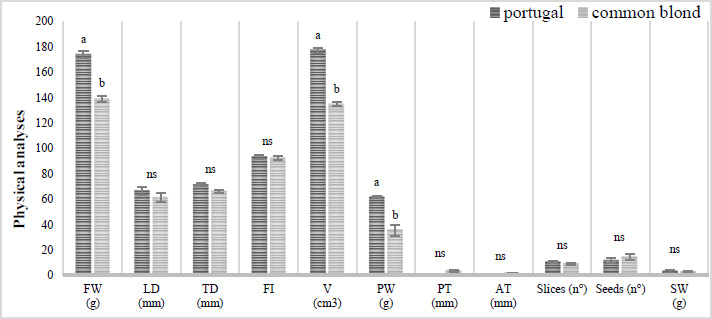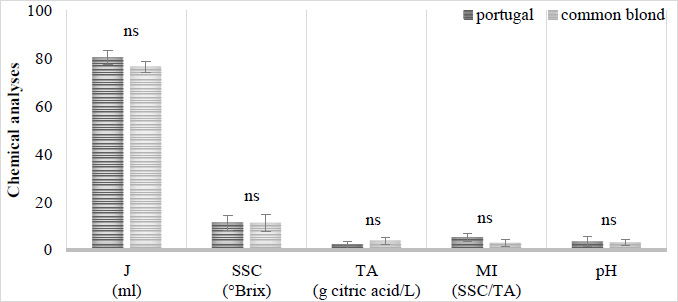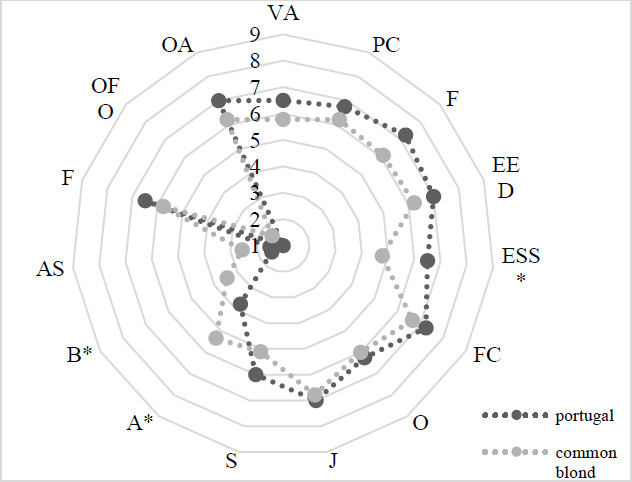RESEARCH ARTICLE
Portugal and Common Blond Oranges: are they the same Variety? Characteristics and Enhancement of the Oldest European Sweet Orange Variety
Roberta Passafiume1, Vittorio Farina1, *, Tommaso La Mantia1
Article Information
Identifiers and Pagination:
Year: 2023Volume: 17
E-location ID: e18743315273225
Publisher ID: e18743315273225
DOI: 10.2174/0118743315273225231121042141
Article History:
Received Date: 20/07/2023Revision Received Date: 30/08/2023
Acceptance Date: 20/08/2023
Electronic publication date: 28/11/2023
Collection year: 2023

open-access license: This is an open access article distributed under the terms of the Creative Commons Attribution 4.0 International Public License (CC-BY 4.0), a copy of which is available at: https://creativecommons.org/licenses/by/4.0/legalcode. This license permits unrestricted use, distribution, and reproduction in any medium, provided the original author and source are credited.
Abstract
Background:
Today, old citrus fruit varieties with traits suited to a market more attentive to a limited territorial distribution of certain species and the preservation of biodiversity are being promoted. One of these is the Portugal orange. The name 'Portugal' disappeared from the writings on citrus fruit growing in the first half of the last century, systematically replaced by the name 'Common Blond'.
Methods:
One hundred fruits of ‘Portugal’ and ‘Common Blond’ oranges come from two varietal collections found in Sicily. Physico-chemical and sensory analyses were carried out to evaluate the qualitative characteristics of both varieties and to confirm or confute the previous hypothesis.
Results:
These analyses confirm that from the point of view of fruit quality, there are no significant differences between 'Portugal' and 'Common Blond' oranges. The differences found can be attributed to the different growing environments, i.e. cultural practices, microclimate, fertilization, etc.
Conclusion:
Furthermore, the historical information provided also supports the hypothesis that the 'Portugal' orange simply changed its name to 'Common Blond', even though there were numerous bud variations that led to the selection of different clones.
1. INTRODUCTION
As it has been recently written [1] “In the last few years, seedlessness has become a major desired trait in many citrus breeding programs worldwide.” At the same time, however, there is the valorization of old citrus varieties that present traits suitable for a market more attentive to the specificities of the territory and the preservation of biodiversity (e.g., orange varieties “Ovaletto of Calatafimi” or “Blonde orange of Scillato”). These are citrus varieties with limited territorial distribution: one of them is the Portugal orange, which, however, is peculiar because it is considered the first sweet orange to arrive in Europe. It is well known that in almost all areas of Italy, oranges are referred to by the name “Portogallo” (Portogal) with many variations (purtualli or partajalli, partuàlli ...) in some parts of Italy (such as in the Viterbo area) the orange seller was called “portogallaro.” The name is also used in many European countries, in Albania (portokall), in Greece “πορτοκάλι” (pronounced portocáli), etc. Historical fruit texts report this name as early as the appearance of sweet oranges in Europe (the bitter orange Citrus x aurantiaum was already present), thus Clarici [2] wrote “Two varieties, which in others are divided, have the Aranci called of Portogallo, and these not well distinguished by some ... the properly called Arancio di Portogallo, which Ferrari and Hermanno have called Orange with sweet peel ... The second is the Arancio dal Brasile transported to Portugal, and thence to Italy, and therefore detto di Portogallo (called of Portugal)”. Targioni-Tozzetti [3] also stated “... the Arancio dal Brasile (Orange from Brazil) transported to Portugal, and thence to Italy, and therefore detto di Portogallo (called of Portugal).” Risso and Poiteau [4] who publish in 1872 the famous “Histoire Naturelle Des Orangers”, wrote about the orange of Portugal and specifically “Cependant le nom de pourtegalié donné à la plupart des Orangers dans le territoire de Nice nous porte à croire qu'au moins ce pays les a reçus du Portugal.”
Sicilian texts describe three varieties of oranges. The most commonly used name is 'Portugal' [5]. One of the most important Sicilian agronomists of the late nineteenth century, left a manuscript upon his death in 1887 [5] where he describes the common orange (Italian name) called in dialect “Aranciu duci, portugallu d'incasciari”. Throughout the agronomic literature of the nineteenth and early twentieth centuries, the orange is referred to as Portugal. The name common blond also begins to appear, Cocuzza Tornello (1911) [6], wrote about the common blond orange “This is the most common variety, then that it is rustic and also productive. ... It is now losing ground ... The variety under consideration should be understood, in botany, by the name of C. Aurantium communis Savastano and vulgarly aranciu partuallu.” The coincidence between Blond communis and Portugal is emphasized by several authors. The name Portugal disappeared from writings on citrus farming from the first half of the last century, and in the 1985 “Treatise on Citrus Farming,” coordinated by Spina [7], for the group of “common blond” oranges, is written “cultivars of little value, which are systematically replaced.” Starting from the historical information on this ancient variety, we wanted to evaluate the quality characteristics of the fruit and compare it with the more common blond orange, with the intention of analysing the fruit quality and verifying their eligibility for genetic analysis to confirm the hypothesis that they are part of the same variety.
2. MATERIALS AND METHODS
2.1. Study Area and Plant Material
The fruit of this trial comes from two varietal collections found in Sicily. Portogallo oranges have been collected in a mixed suburban orchard (Fondo Micciulla) in the Conca d’Oro plain. The orchard is one of the last in the surrounding city of Palermo and has been characterized over the centuries by the presence of the mixed orchard. Several tree species in the surveyed area are Citrus spp., Eriobotrya japonica (Thunb.) Lindl, other fruit species (plums, apricot, pear), walnut (Juglans regia L.), blackberry (Celtis australis L.), and Bay laurel (Laurus nobilis L.) [8, 9]. The favourable environmental conditions together and the agronomic practices introduced by the Arabs permit the cultivation of many species of fruits and vegetable species in the gap of canopies. The mean annual precipitation is 747 mm, the mean annual temperature is 18.8 °C and the soils are Typic rhodoxeralfs [9]. The fruit of Biondo Comune was picked in CREA-ACM of Acireale. The soil is typic Xerochrept, the mean annual precipitation is 783 mm, and the mean annual temperature is 18.0 °C [10, 11]. Plants were submitted to routinary cultural cares.
One hundred fruits of ‘Portogallo’ and ‘Biondo comune’ oranges were hand-picked in February 2018 as follows: ten fruits × ten plants × two cultivars. After harvest, the fruits were transported to the post-harvest laboratories of the University of Palermo (Sicily – Italy) and were analysed as follows.
2.2. Physico-chemical Analysis
Concerning the quality analyses, a digital scale (Gibertini EU–C 2002 RS, Novate Milanese, Italy) was used to evaluate fruit weight (FW - g), peel weight (PW – g) and seeds weight (SW – g); longitudinal diameter (LD – mm), transversal diameter (TD – mm), fruit index (FI), peel thickness (PT – mm) and albedo thickness (AT – mm) were determined using a digital calliper (TR53307 - Turoni, Forlì, Italy); the volume was determined through a liquid displacement method (V – cm3). The peel and flesh colour was recorded using a Minolta CR-400 colorimeter (Konica Minolta Sensing, Inc., Japan) using the CIEL*a*b* colour space: L* indicates the brightness (from 0 – white - to 100 - black), a* ranges from green (−100*) to red (+100*), and b* varies from blue (−100*) to yellow (+100*); peel colour index (PCI) was determined using the following equation:
CI= 1000a*/(L*b*)
Finally, the number of slices (slices – n°) and the number of seeds (seeds – n°) were also determined.
2.3. Chemical Analyses
The orange slices were separated from the peel and albedo and the juice was extracted with a manual citrus squeezer to determine the juiciness (J - ml) of the fruit and its pH. Subsequently, an Atago Palette PR–32 digital refractometer (Atago Co., Ltd., Tokyo, Japan) was used to determine the total soluble solids content (TSSC - °Brix), while titratable acidity (TA) was determined by titrating 10 mL of juice with NaOH (0.1 N) to pH 8.1. The result was expressed as a percentage of citric acid x L.
2.4. Sensory Analysis
The sensory analysis was carried out by a group of panellists trained with broad expertise in the sensory evaluation of foods [12]. Fifteen qualitative descriptors were considered: visual appearance (VA), peel colour (PC), firmness (F), easy epicarp detachment (EED), easy separation of slices (ESS), flesh colour (FC), odour (O), juiciness (J), sweetness (S), acidity (A), bitterness (B), astringent (AS), flavour (F), off-odour (OFO), overall assessment (OA). The judges assessed the intensity of each attribute on a discontinuous scale from 1 (absence of the descriptor) to 9 (maximum intensity of the descriptor). Water was provided for rinsing their mouths between the different orange samples. The sensory profile of each cultivar was reported in spider plots.
3. RESULTS AND DISCUSSION
3.1. Physico-chemical Analysis
Fruit weight, peel colour, and fruit index are considered crucial for determining the commercial quality of the fruit [13, 14]. Portugal also produced the largest fruit for fresh weight and volume (Fig. 1). They differ by 20% in size. Furthermore, the two varieties diverge in peel weight: Common Blond shows almost half of the peel weight compared to the first. However, Common Blond fruit had a greater edible portion than Portugal oranges and the market preference is for fruits with a higher percentage of edible portion [15]. These differences could be associated with different factors linked to collection fields: cultivation methods and soil characteristics could influence fruit development [16-18]. On the northwest coast of Sicily where Portugal was picked, soils are rich in limestone and carbonate rocks while on the southeast coast where Common Blond ripens are rich in the soils volcanic rocks, alluvial deposits, sandstones, and clays.
 |
Fig. (1). Analyses of the physical characteristics of Portugal and common blond oranges. |
Columns indicate the means; bars indicate the standard deviation (SD) of three replicates (n=3). For each bar, different letters indicate significant differences (p ≤ 0.05) by Tukey's multiple range test, while ‘ns’ indicates not statistical differences between Portugal and Common Blond varieties. Fresh weight (FW), longitudinal diameter (LD), transversal diameter (TD), fruit index (FI), volume (V), peel weight (PW), peel thickness (PT), albedo thickness (AT), slice weight (SW).
No statistically significant differences were found for the peel and flesh colours (Fig. 2-3) except for the flesh yellowness (b*). This fact could be due to the different climatic areas where the samples were taken. In fact, climate, which is the most important component in the climate-soil complex, appears to be responsible for differences in fruit quality among commercial citrus production areas [17].
Concerning the chemical analyses, none of the analysed parameters showed significant differences between the two observed varieties (Fig. 4). Juiciness was for both varieties about 80 ml, and the soluble solids content reached more than 11 °Brix in both varieties.
 |
Fig. (4). Analyses of differences in chemical characteristics between Portugal and common blond oranges. |
 |
Fig. (5). Sensory analysis of Portugal and common blond orange varieties. |
Columns indicate the means; bars indicate the standard deviation (SD) of three replicates (n=3). For each bar, ‘ns’ indicates no significant differences (p ≥ 0.05) between Portugal and Common Blond varieties, by Tukey's multiple range test.
Hence, sensory analysis was carried out to confirm the precedent results (Fig. 5).
Legend: visual appearance (VA), peel color (PC), firmness (F), easy epicarp detachment (EED), easy separation of slices (ESS), flesh colour (FC), odour (O), juiciness (J), sweetness (S), acidity (A), bitterness (B), astringent (AS), flavour (F), off-odour (OFO), overall assessment (OA). Highlights statistically significant differences (p≤0.05) between the two analysed varieties.
Concerning sensory analysis, there were very few differences characterised in the two analysed cultivars. Significant differences were highlighted just in terms of easy peeling, acidity, and bitter taste (B) of the flesh.
CONCLUSION
Historical information on the presence of Portugal plants in Europe and the dynamics of the spread of the Common Blonde suggests a common denominator between the two varieties.
This preliminary work paves the way for new research involving the in-depth study of varieties by molecular analysis. The results of the pomological traits, although showing some differences probably due to the origin of the two samples, cannot exclude a strong similarity between the two types of oranges. For this reason, this work aims to be a starting point for a more accurate study using pomological descriptors and genetic studies to affirm a possible unique identity of Portugal and the Common Blonde. Based on this study and forthcoming insights about genetic analysis, it could then be proposed that the old designation “orange of Portugal” be reinstated. Some orange ancient clones are often grown in very small areas such as the “ovaletto di calatafimi” and the “arancia bionda di scillato” limited to oranges and Sicily. These are varieties connected to distinctive patches of landscape as the Conca D'Oro included in the “national catalogue of historic rural landscapes” where the Portugal orange is still cultivated. In the case of the Portugal orange, the excellent qualities of the fresh product but also of the juice have allowed its valorisation and today the juice is also marketed abroad. At the same time, the old plants that survive in the promiscuous citrus groves of the Conca D’Oro are the witnesses of the history of citrus farming.
LIST OF ABBREVIATIONS
| VA | = Visual Appearance (VA) |
| PC | = Peel Colour |
| EED | = Easy Epicarp Detachment |
| ESS | = Easy Separation of Slices |
| FC | = Flesh Colour |
| OFO | = Offodour |
| OA | = Overall Assessment |
| SD | = Standard Deviation |
CONSENT FOR PUBLICATION
Not applicable.
AVAILABILITY OF DATA AND MATERIALS
The data and supportive information is available within the article.
FUNDING
None.
CONFLICT OF INTEREST
Dr. Vittorio Farina is the Associate Editorial Board Member of the journal The Open Agriculture Journal.
ACKNOWLEDGEMENTS
The authors wish to thank the Centre for Citrus Farming (CREA-ACM Acireale) (now the Center for Research in Olive, Fruit and Citrus Farming of the Council for Agricultural Research and Analysis of Agricultural Economics - CREA-OFA).










